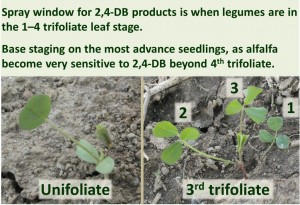Rain in the past week ranged from 25 to 100 mm across the region. The upper valley and the far east of the region received the most. During the month of May the region accumulated roughly 450 Crop Heat Units (CHUs) or about 20 CHUs above the 30 year average. Precipitation was extremely variable across the area, but across the area, the total for May is sitting around 85 mm, which is just a few mm above our 30 year average.
Forages: Most forage stands are ready to harvest. Although the alfalfa is just in the bud stage, most grasses are well into heading. Yields on some early cut stands have been reported at 2/3 to 3/4 of normal yields. Alfalfa weevils have been reported in southwestern Ontario, but are only present in very low numbers eastern Ontario.
2013 new seedings have been slow to emerge, mostly due to low soil moisture in early May. Most early seeded stands range in stage from unifoliate to 3rd trifoliate (Figure 1). Broadleaf weed herbicides can be applied up to the 4th trifoliate.

Cereals: Winter wheat is now in the flag leaf stage. We are now past the spray window for herbicides in winter wheat.
The spring cereals planted in the last week of April are now in the fully tillered to first node stage (Zadok’s Stage 30-31). Cereals planted too shallow, not proper packed and/or planted l2 inches or deeper emerged unevenly, which will impact the timing of the fungicides application for fusarium control. The window for herbicide application is getting late. Annual grasses are close to tillering, but are generally thin. Growers who have not yet sprayed, may want to include a fungicide for early leaf disease control with the herbicide. Research has shown between 1 to 2 bushel per acre yield increase from a fungicide applied at this stage.
No visible disease pressure yet. Stripe & Leaf rusts are making their way to central US. The USDA cereal rust disease bulletins will assist in tracking progress: (http://www.ars.usda.gov/Main/docs.htm?docid=9757).
Corn: Corn is light in colour due to the cool temperatures in the past several days (Figure 2). Colour will improve as temperatures improve later this week. Some soil crusting problems on some of the heavier soils.

Soybeans: If planting soybeans after 1st cut hay, there is no benefit to switching to shorter maturity soybeans unless planting date is delayed past June 15th. If planting later than the first week of June, increase seeding rates by 10%.
Crop Insurance: Report planted acres by June 30th. Premiums due by July 10th.
Planting date deadlines for crop insurance coverage:
Corn Grain – June 10th
Silage Corn – June 17th
Soybeans – June 30th
Resources:
Revised Guide to Weed Control, Pub 75 as pdf, 2013 revisions highlighted in yellow
Protecting Pollinators During Corn Planting SeasonWeedPro75 – Herbicide Selector (smart phone/mobile version at: m.weedpro75.com )
Weed Info website – knowledge base of weed information website
CropLine – 1-888-449-0937
CropPest Website
Eastern Ontario Crop Diagnostic Day will be on Tuesday, July 16, 2013 at the Winchester Research Farm of the University of Guelph, Kemptville Campus. Still opportunity to have input into the demonstration stops.
NEXT MEETING: Country Kitchen, Winchester, 7:30 am, June 11, 2013
|
Scott Banks (613) 294-4436 Cell |
Gilles Quesnel Twitter: @GillesQuesnel |